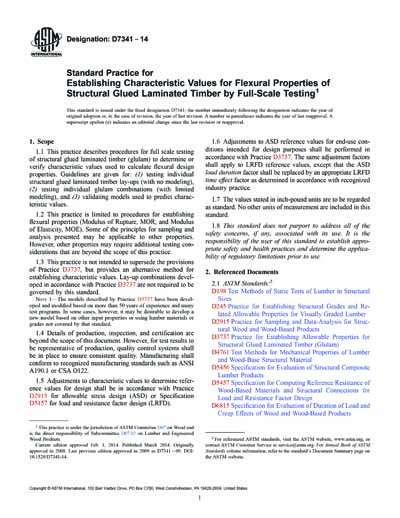Historical
ASTM D7341-14
Standard Practice for Establishing Characteristic Values for Flexural Properties of Structural Glued Laminated Timber by Full-Scale Testing
1.1 This practice describes procedures for full scale testing of structural glued laminated timber (glulam) to determine or verify characteristic values used to calculate flexural design properties. Guidelines are given for: (1) testing individual structural glued laminated timber lay-ups (with no modeling), (2) testing individual glulam combinations (with limited modeling), and (3) validating models used to predict characteristic values.
1.2 This practice is limited to procedures for establishing flexural properties (Modulus of Rupture, MOR, and Modulus of Elasticity, MOE). Some of the principles for sampling and analysis presented may be applicable to other properties. However, other properties may require additional testing considerations that are beyond the scope of this practice.
1.3 This practice is not intended to supersede the provisions of Practice D3737, but provides an alternative method for establishing characteristic values. Lay-up combinations developed in accordance with Practice D3737 are not required to be governed by this standard.
1.4 Details of production, inspection, and certification are beyond the scope of this document. However, for test results to be representative of production, quality control systems shall be in place to ensure consistent quality. Manufacturing shall conform to recognized manufacturing standards such as ANSI A190.1 or CSA O122.
1.5 Adjustments to characteristic values to determine reference values for design shall be in accordance with Practice D2915 for allowable stress design (ASD) or Specification D5457 for load and resistance factor design (LRFD).
1.6 Adjustments to ASD reference values for end-use conditions intended for design purposes shall be performed in accordance with Practice D3737. The same adjustment factors shall apply to LRFD reference values, except that the ASD load duration factor shall be replaced by an appropriate LRFD time effect factor as determined in accordance with recognized industry practice.
Content Provider
ASTM International [astm]






